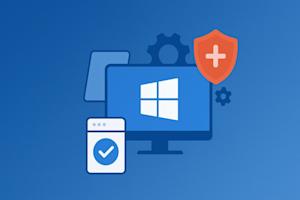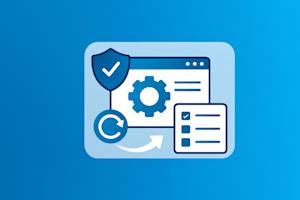Microsoft Intune è una soluzione di gestione degli endpoint basata su cloud che aiuta gli utenti ad accedere alle risorse di cui hanno bisogno semplificando la gestione delle app e dei dispositivi. Questo lo ha reso uno strumento popolare per le aziende, soprattutto mentre abbracciano il lavoro remoto e ibrido. Tuttavia, Intune ha un punto critico significativo: il suo processo di patch.
I cicli di patch di Intune possono richiedere ore per essere applicati, spesso arrivando a otto ore o più, e la copertura delle patch di terze parti è limitata al massimo. Sebbene le organizzazioni debbano mantenere i loro endpoint completamente aggiornati e patchati, questi lunghi cicli di patch possono anche ridurre significativamente la produttività.
Allora, come possono le organizzazioni ridurre i ritardi nei cicli di patch di Intune? Un'opzione è integrare Intune con una soluzione di automazione delle patch in tempo reale come Splashtop AEM per colmare le lacune in velocità, visibilità e copertura di terze parti.
Perché i ritardi nel patching di Intune contano
Il patching e la gestione delle patch sono aspetti essenziali della sicurezza informatica. Le patch software spesso includono aggiornamenti di sicurezza per affrontare nuove e conosciute vulnerabilità, quindi non installarle può lasciare dispositivi e applicazioni esposti a cyberattacchi. Di conseguenza, molte normative di settore e governative impongono patching rapido; altrimenti, le aziende non riusciranno a soddisfare i loro requisiti di conformità IT.
Il ritardo nel patching può aumentare l'esposizione a vulnerabilità conosciute, portando al fallimento degli audit di conformità, a una maggiore superficie di attacco e, naturalmente, a un rischio maggiore di un catastrofico cyberattacco. Allo stesso tempo, senza un'adeguata gestione delle patch, una patch può essere segnata come "distribuita" anche se non è completamente installata su tutti i punti di contatto, creando una falsa sensazione di sicurezza.
Allo stesso tempo, le aziende vogliono rimanere impegnate e produttive, ma le patch possono richiedere tempo, soprattutto quando ci sono più endpoint da aggiornare. Di conseguenza, i dipendenti spesso ritardano i lunghi processi di patching per concentrarsi sul lavoro, lasciando a rischio i loro dispositivi.
Cause Principali dei Patching Lenti in Intune
Data l'importanza del patching tempestivo, ci si deve chiedere: cosa rende il patching Intune così lento? Diversi fattori possono contribuire a una lentezza nel patching, tra cui:
Controlli saltuari: Per correggere un dispositivo con Intune, non deve solo essere online ma anche effettuare il check-in. Questo può comportare aggiornamenti più lenti, poiché il processo è meno automatico o frequente.
Controllo limitato: Intune utilizza cicli di patch programmati che non sono ottimizzati per il deployment di patch urgenti o guidati dagli eventi, il che può creare ritardi durante scenari di vulnerabilità zero-day o ad alto rischio. Se una nuova patch necessaria urgentemente viene rilasciata tra gli aggiornamenti programmati, Intune non la raggiungerà fino al suo prossimo aggiornamento programmato. Questo crea un divario significativo tra il rilascio della patch e la sua installazione, che rappresenta un rischio per la sicurezza.
Lacune di terze parti: Intune si concentra principalmente sui prodotti Microsoft. Il patching di terze parti è limitato e spesso richiede strumenti aggiuntivi, script o processi manuali, il che può lasciare comuni applicazioni senza patch
Reti a bassa latenza: Se un endpoint remoto ha bisogno di patching, le connessioni a bassa larghezza di banda possono rallentarlo significativamente. Questo può essere un problema per gli utenti che si affidano ai VPN o in aree con connettività limitata, poiché può ritardare il loro accesso a patch di cui hanno urgente bisogno.
Quando si confronta con soluzioni di gestione delle patch in tempo reale, la differenza in termini di velocità ed efficienza diventa chiara:
Microsoft Intune | Patching in tempo reale | |
Velocità di Distribuzione delle Patch | Dipendenti da scansioni e check-in programmati, le patch possono richiedere ore o giorni per essere distribuite attraverso i punti di contatto. | Rileva e distribuisce le patch non appena diventano disponibili, senza aspettare i controlli programmati. |
Disponibilità del dispositivo | I dispositivi devono essere online e connessi a Intune; gli endpoint offline possono perdere le finestre di patch. | Distribuisce le patch immediatamente quando i dispositivi si collegano online. |
Visibilità | La segnalazione può ritardare rispetto allo stato reale delle patch, quindi potrebbe richiedere tempo confermare la conformità. | Fornisce visibilità in tempo reale sullo stato delle patch, la conformità e le vulnerabilità. |
Supporto di app di terze parti | Supporta principalmente prodotti Microsoft; il patching di terze parti richiede strumenti o script aggiuntivi. | Supporta nativamente il patching sia per sistemi operativi che per applicazioni di terze parti. |
Security Risk Window | Un'esposizione più lunga tra il rilascio delle patch e il loro deployment aumenta il rischio di vulnerabilità. | Riduce al minimo l'esposizione riducendo il tempo tra patch e distribuzione a pochi minuti. |
Come Splashtop AEM velocizza la gestione delle patch
Se stai utilizzando Microsoft Intune ma vuoi una gestione delle patch più veloce e automatizzata, puoi utilizzare software di gestione degli endpoint insieme a Intune. Splashtop AEM (Gestione autonoma degli endpoint) è un ottimo complemento a Microsoft Intune, in quanto offre una gestione delle patch in tempo reale su dispositivi remoti e endpoint distribuiti.
Il patching in tempo reale di Splashtop AEM rileva gli aggiornamenti disponibili immediatamente e automatizza la distribuzione su tutti gli endpoint, riducendo il tempo tra il rilascio della patch e l'installazione. Questo mantiene le patch aggiornate il più rapidamente possibile, anziché aspettare tra gli aggiornamenti pianificati.
Splashtop AEM funziona su diverse piattaforme e sistemi operativi, offrendo patching in tempo reale per Windows, macOS e molte applicazioni di terze parti. Piattaforme aggiuntive come Android e ChromeOS sono supportate per casi d'uso di inventario e gestione. Gli aggiornamenti su tutte queste piattaforme sono visibili da un'unica dashboard unificata, rendendo facile tracciare i progressi del patching.
Le organizzazioni possono anche impostare le proprie politiche di patching su Splashtop AEM basate sulle loro esigenze normative e aziendali. Ciò consente di innescare automaticamente gli aggiornamenti in base al livello di rischio CVE o eventi, o di impostare politiche su come le patch dovrebbero essere priorizzate e installate.
Quando utilizzato insieme a Intune, Splashtop AEM offre un controllo ancora maggiore sulle patch, una rapida distribuzione delle patch e una reportistica più approfondita, fornendo alle organizzazioni robuste capacità di gestione delle patch.
Come combinare Intune e Splashtop AEM per migliorare il patching
Detto ciò, come si combinano Intune e Splashtop? Il processo è semplice, quindi le organizzazioni possono rapidamente impostare Splashtop AEM, integrarlo con Intune e sbloccare nuove capacità robuste di gestione delle patch e degli endpoint:
Distribuisci Splashtop AEM: Splashtop AEM può essere aggiunto accanto ai dispositivi gestiti da Intune esistenti senza conflitti o requisiti di disinstallazione.
Crea politiche: Puoi impostare politiche di patching automatizzate personalizzate in Splashtop AEM per categorie come gravità, tipo di app e requisiti di conformità.
Imposta trigger in tempo reale: Splashtop AEM può essere impostato per distribuire immediatamente patch di emergenza o a zero-day.
Monitora: Puoi tracciare lo stato delle patch e le informazioni sulle vulnerabilità tramite la dashboard di Splashtop AEM.
Report: Quando hai bisogno di riportare i risultati di conformità agli auditor interni o esterni, la reportistica di Splashtop AEM fornisce informazioni dettagliate per dimostrare la sicurezza e la conformità IT.
Vantaggi di sicurezza e conformità della gestione delle patch con Splashtop AEM
Naturalmente, Splashtop AEM fa più che aiutare a installare le patch più rapidamente (anche se questo è un grande vantaggio). La gestione delle patch di Splashtop AEM aiuta a garantire una migliore sicurezza e conformità IT mantenendo gli endpoint aggiornati riducendo il carico sui team IT.
Innanzitutto, la gestione automatizzata delle patch di Splashtop AEM aiuta ad accelerare il processo di patching. Splashtop AEM può rilevare automaticamente nuove patch, programmare aggiornamenti su tutti gli endpoint, distribuire l'aggiornamento in anelli di test e distribuirle a ciascun endpoint, riducendo il tempo medio per la risoluzione (MTTR). Questo aiuta a mantenere i dispositivi sicuri e aggiornati, supportando gli sforzi di conformità per quadri come SOC 2, ISO 27001, PCI e HIPAA riducendo l'esposizione alle vulnerabilità conosciute.
Allo stesso tempo, Splashtop AEM riduce la necessità di interventi manuali. Poiché Splashtop AEM automatizza la gestione delle patch, gli agenti IT possono trascorrere meno tempo aggiornando manualmente ciascun endpoint e più tempo a concentrarsi su questioni più complesse o urgenti. L'automazione riduce anche l'errore umano eliminando il rischio di saltare o dimenticare accidentalmente di aggiornare un endpoint.
Per quanto riguarda la priorizzazione delle patch e dei rischi, Splashtop AEM utilizza i dati CVE (Common Vulnerabilities and Exposures) per identificare e prioritizzare le minacce. Splashtop AEM fornisce insight CVE in tempo reale e visibilità delle vulnerabilità per aiutare i team a prioritizzare e affrontare rapidamente i rischi.
Come Funziona Splashtop AEM
Splashtop AEM è progettato per aiutare a semplificare le operazioni IT, automatizzare le attività e mantenere gli endpoint sicuri e conformi da un'unica posizione. Con essa, gli amministratori IT e gli agenti possono gestire senza problemi gli endpoint distribuiti, indipendentemente dal dispositivo o dal sistema operativo, supportando efficacemente ambienti di lavoro remoti e ibridi mentre lavorano da qualsiasi luogo.
Splashtop AEM include:
Visibilità in tempo reale: Visualizza immediatamente i dati delle patch e CVE da un'unica dashboard.
Distribuzione istantanea e automatizzata: Scarica, testa e distribuisci aggiornamenti non appena sono disponibili.
Reportistica unificata: Ottieni una visione olistica di tutti gli stati delle patch, delle versioni OS e del software di terze parti da una dashboard facile da usare.
Libreria di automazione: Usa politiche predefinite per Windows, macOS e app critiche di terze parti, o personalizza le tue politiche.
Quando I Team IT Dovrebbero Aggiungere Splashtop AEM
Questo porta a una domanda importante: quali sono i segni che un'azienda dovrebbe utilizzare Splashtop AEM insieme a Intune? Poniti le seguenti domande:
I tuoi team stanno sperimentando ritardi o fallimenti nel deployment delle patch Intune?
La tua organizzazione utilizza più sistemi operativi (incluse le politiche di BYOD (portare il dispositivo)), oltre a Windows?
Il tuo team IT deve supportare più endpoint o siti che richiedono una rapida convalida delle patch, oppure sei un MSP con diversi clienti che richiedono lo stesso?
Stai puntando alla preparazione zero-trust o alla conformità IT continua?
Se hai risposto "sì" a una di queste, è il momento di iniziare con Splashtop AEM. Con esso, puoi migliorare la tua sicurezza, accelerare la distribuzione delle patch e garantire che i tuoi endpoint siano aggiornati indipendentemente dal sistema operativo o dal dispositivo.
Naturalmente, Splashtop AEM è una soluzione di gestione degli endpoint potente, robusta e user-friendly di per sé, quindi anche se non stai usando Intune, potrebbe comunque essere ciò di cui la tua azienda ha bisogno per mantenere gli endpoint sicuri.
Risolvi i Ritardi di Patching di Intune con l'Automazione in Tempo Reale
Se il patching di Intune è stato troppo lento per te, c'è una soluzione. Splashtop AEM completa Intune automatizzando il patching su tutti gli endpoint, lavorando senza intoppi accanto ad esso senza sostituirlo. Di conseguenza, puoi soddisfare i tuoi requisiti di conformità normativa, mantenere una forte sicurezza, ridurre i rischi e distribuire aggiornamenti rapidamente.
Splashtop AEM fornisce ai team IT gli strumenti e la tecnologia di cui hanno bisogno per monitorare gli endpoint, affrontare proattivamente i problemi e ridurre i loro carichi di lavoro. Questo include:
Patch automatiche per il sistema operativo, app di terze parti e app personalizzate.
Approfondimenti sulle vulnerabilità basati su CVE potenziati dall'IA.
Strutture di policy personalizzabili che possono essere applicate in tutta la tua rete.
Gestione dell'inventario hardware e software su tutti gli endpoint.
Avvisi e correzioni per risolvere automaticamente i problemi prima che diventino problemi.
Azioni in background per accedere a strumenti come gestori attività e gestori dispositivi senza interrompere gli utenti.
Pronto a provare Splashtop AEM di persona? Inizia oggi con una prova gratuita:





